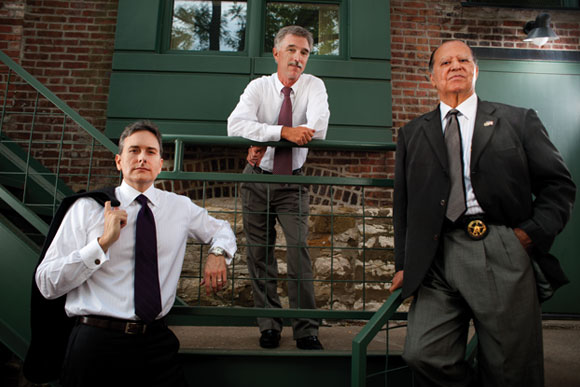by Amanda Bertholf // Fall 2011

Outside a Miami nightclub after a fire
Quentin Haid: The club was grandfathered in—built pre-code.
Lt. Horatio Caine: Yeah, I bet you those chained exit doors were grandfathered in, too, huh?
Haid: What’d you expect me to do? People were sneaking in.
Lt. Caine: And dying to get out.
In 2009, the TV show CSI: Crime Scene Investigation topped more than 73.8 million viewers worldwide. CSI has been going strong for 11 seasons and has spun off several series. Today, more than 250 episodes of the show have aired. While we probably don’t tune in for the riveting dialogue—like that from an episode of CSI: Miami, above—there’s something about bullet-proof vests, guns, murder, DNA, exotic locales and car chases that keep us coming back for more. Clearly, we’re hooked.
This desire to tune in stems from a fascination with a system that could control and ruin people’s lives—and the crime genre feeds that obsession, according to our experts. “We like fairy tales, and that’s what these shows are,” says Alex Holsinger, associate professor of criminal justice and criminology at UMKC. They portray the idea of good versus evil, and in the end, more often than not, good wins.
The struggle of good versus evil playing out on TV opens a window to stark contrasts in society, and the result is a morality tale wrapped up neatly into 45 minutes. There’s a victim, a villain and a vindicator, and that’s what makes crime so addictive, says Ted Hunt, J.D. ’92, chief trial attorney in the Jackson County prosecutor’s office in Kansas City, Mo.
People are also fascinated by crime because they fear it. “When we’re watching these shows, we want to know: How did that person get victimized, what put him or her in that situation, how did that person become vulnerable and how can I avoid that in the future?” Hunt says. In addition to feeding society’s curiosity, the shows provide finality and answers to life’s questions. And viewers get that finality when a show ends with an arrest or conviction. “We get as close to truth with a capital ‘T’ as we can get,” Hunt says. “The crime genre plays on that.”
But too often audiences see a depiction of the criminal justice system that isn’t realistic. “It doesn’t give you a true picture of what happens, but it’s close,” says Al Lomax, B.S.A.J. ’75, who was appointed by President Barack Obama to be a U.S. Marshal and was sworn in this summer. Lomax says some shows, like CSI, are sometimes accurate but the main goal isn’t accuracy—it’s to get you to tune in again. “Most of it is strictly drama,” he says. At the end of the day, viewers want to forget the stress of the office and be entertained, and that’s the goal of this genre. But how do viewers separate fact from fiction? Our experts dissect the five myths of Hollywood glitz and what’s real.
